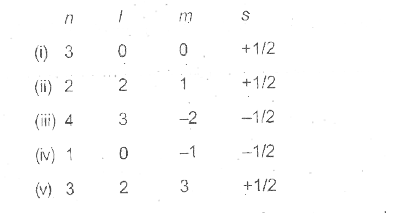Which of the following sets of quantum number is //are not perrmitted ?
n=3,l=3,m=+1,s=+12
n=3,l=2,m=+2,s=−12
n=3,l=1,m=+2,s=−12
n=3,l=0,m=0,s=+12
The correct Answer is:A, B, C
To determine which sets of quantum numbers are not permitted, we need to understand the rules governing quantum numbers:
1. Principal Quantum Number (n): This number can take any positive integer value (n = 1, 2, 3,...).
2. Azimuthal Quantum Number (l): This number can take integer values from 0 to (n-1). Therefore, for a given n, l must be less than n.
3. Magnetic Quantum Number (m): This number can take integer values from -l to +l, including 0.
4. Spin Quantum Number (s): This number can be either +1/2 or -1/2.
Now, let's analyze the given sets of quantum numbers one by one:
Option 1: n = 3, l = 3, m = 1, s = +1/2
- n = 3: Valid
- l = 3: Not valid because l must be less than n (l can be 0, 1, or 2 for n = 3).
- m = 1: Valid (but irrelevant since l is invalid).
- s = +1/2: Valid.
Conclusion: This set is not permitted due to the invalid l value.
Option 2: n = 3, l = 2, m = 2, s = -1/2
- n = 3: Valid
- l = 2: Valid (l can be 0, 1, or 2 for n = 3).
- m = 2: Valid (m can be -2, -1, 0, 1, 2 for l = 2).
- s = -1/2: Valid.
Conclusion: This set is permitted.
Option 3: n = 3, l = 1, m = 2, s = -1/2
- n = 3: Valid
- l = 1: Valid (l can be 0, 1, or 2 for n = 3).
- m = 2: Not valid because m must be in the range of -l to +l (for l = 1, m can be -1, 0, or 1).
- s = -1/2: Valid.
Conclusion: This set is not permitted due to the invalid m value.
Option 4: n = 3, l = 0, m = 0, s = +1/2
- n = 3: Valid
- l = 0: Valid (l can be 0, 1, or 2 for n = 3).
- m = 0: Valid (for l = 0, m can only be 0).
- s = +1/2: Valid.
Conclusion: This set is permitted.
Final Summary:
- Not Permitted: Option 1 (l value is invalid) and Option 3 (m value is invalid).
- Permitted: Option 2 and Option 4.
2. Azimuthal Quantum Number (l): This number can take integer values from 0 to (n-1). Therefore, for a given n, l must be less than n.
3. Magnetic Quantum Number (m): This number can take integer values from -l to +l, including 0.
4. Spin Quantum Number (s): This number can be either +1/2 or -1/2.
- n = 3: Valid
- l = 3: Not valid because l must be less than n (l can be 0, 1, or 2 for n = 3).
- m = 1: Valid (but irrelevant since l is invalid).
- s = +1/2: Valid.
- n = 3: Valid
- l = 2: Valid (l can be 0, 1, or 2 for n = 3).
- m = 2: Valid (m can be -2, -1, 0, 1, 2 for l = 2).
- s = -1/2: Valid.
- n = 3: Valid
- l = 1: Valid (l can be 0, 1, or 2 for n = 3).
- m = 2: Not valid because m must be in the range of -l to +l (for l = 1, m can be -1, 0, or 1).
- s = -1/2: Valid.
- n = 3: Valid
- l = 0: Valid (l can be 0, 1, or 2 for n = 3).
- m = 0: Valid (for l = 0, m can only be 0).
- s = +1/2: Valid.
- Not Permitted: Option 1 (l value is invalid) and Option 3 (m value is invalid).
- Permitted: Option 2 and Option 4.
Topper's Solved these Questions
- ATOMIC STRUCTUREBOOK - CENGAGE CHEMISTRY ENGLISHCHAPTER - ATOMIC STRUCTUREEXERCISE - Exercises Single Correct
127 Videos
- ATOMIC STRUCTUREBOOK - CENGAGE CHEMISTRY ENGLISHCHAPTER - ATOMIC STRUCTUREEXERCISE - Exercises Assertion And Reason
21 Videos
- ATOMIC STRUCTUREBOOK - CENGAGE CHEMISTRY ENGLISHCHAPTER - ATOMIC STRUCTUREEXERCISE - Exercises Linked Comprehension
50 Videos
- APPENDIX - INORGANIC VOLUME 1BOOK - CENGAGE CHEMISTRY ENGLISHCHAPTER - APPENDIX - INORGANIC VOLUME 1EXERCISE - chapter-7 Single correct answer
1 Videos
- CHEMICAL BONDING AND MOLECULAR STRUCTUREBOOK - CENGAGE CHEMISTRY ENGLISHCHAPTER - CHEMICAL BONDING AND MOLECULAR STRUCTUREEXERCISE - Archives Subjective
15 Videos
Similar Questions
Which of the following set of quantum number is are not permitted ?
View SolutionWhich of the following sets of quantum number is not possible
View SolutionWhich of the following sets of quantum number is not possible
View SolutionWhich of the following sets of quantum number is//are permitted?
View SolutionWhich of the following set of quantum numbers is not valid.
View SolutionWhich of the following sets of quantum number is allowable
View SolutionWhich of the following set of quantum number is possible ?
View SolutionConsider the following sets of quantum number

Which of the following sets of quantum number is not possible ?
View SolutionWhich of the following sets of quantum numbers are correct?
n l m n l m
View SolutionQuantum Numbers
View Solution
